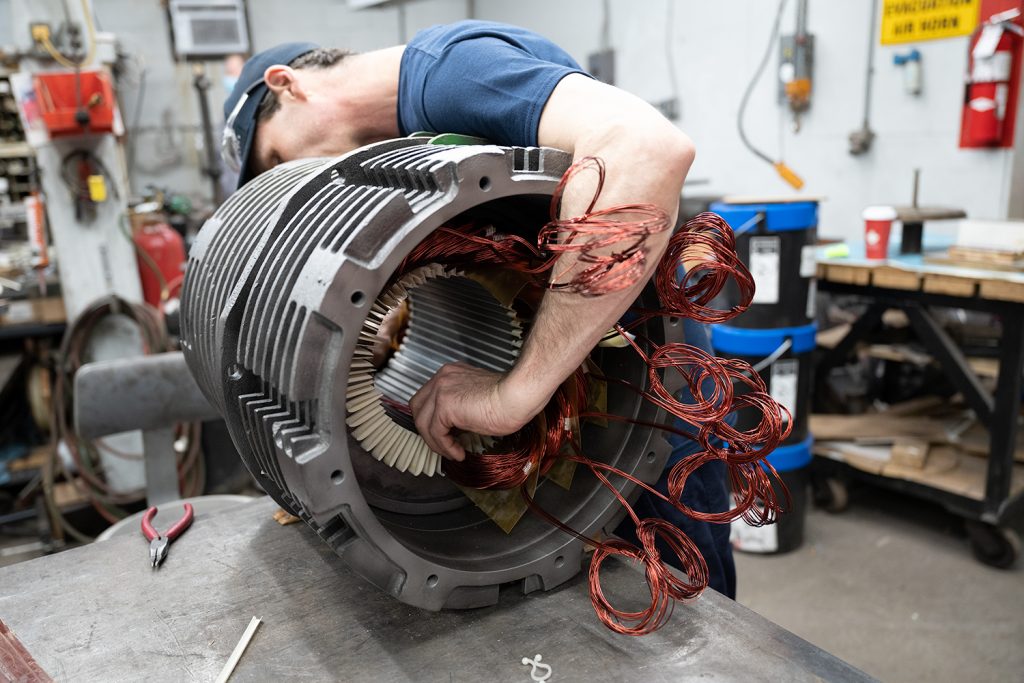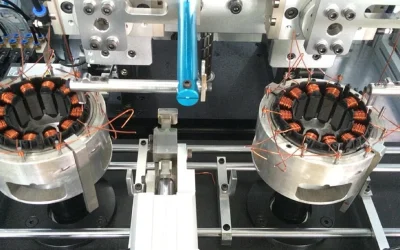DC brush commutator motors are crucial for powering a wide range of industrial applications, from small gadgets to large machinery. Their adaptability and efficiency make them indispensable in industries such as manufacturing, transportation, and mining. These motors are commonly used to operate conveyor belts, mechanical arms, electric vehicles, and large mining machines. A significant advantage of DC motors is their ability to provide precise control over speed and torque, making them ideal for applications requiring consistent and repeatable performance. In both factory and field settings, DC motors play a vital role in ensuring the smooth and efficient operation of industrial processes.
Recommendations for DC Motor Maintenance
Despite their efficiency, DC motors require regular maintenance to ensure optimal performance and longevity. Proper maintenance extends the life of the motors, reduces costly repairs, and minimizes downtime. Key maintenance tasks include checking and replacing brushes, greasing ball bearings, and ensuring correct alignment for smooth operation. Additionally, it is important to maintain cleanliness by removing dust and debris that can accumulate on the motor housing and ventilation system, as these can lead to overheating and disrupt electrical flow.
Lubrication is another critical aspect of DC motor maintenance. While some motors are self-lubricating, others require periodic lubrication to keep bearings functioning smoothly. Monitoring motor performance is also essential, involving regular readings of parameters such as vibration levels, operating temperature, and current draw to identify potential issues early. By adhering to a comprehensive maintenance plan, industries can ensure that their DC motors continue to operate efficiently, reducing the risk of unexpected failures and extending the various types of equipment’s overall lifespan.
Why Regular Maintenance Matters?
Regular maintenance of DC motors is important for the following reasons:
Avoids Unknown Failures: Regular checks can ensure the presence of a potential problem before it eliminates your engine.
Motor Life: The effective operation life of a motor might get significantly extended as opposed to that without regular maintenance.
Efficiency: A well-maintained motor will have more efficiency means less energy consumption.
Decreases downtime: Planned maintenance eliminates surprise breakdowns, guaranteeing constant filming time.
DC Motor Kit Maintenance Machinery
To effectively maintain and repair DC motors, specialized tools and machinery are essential for ensuring optimal performance. At CAM Innovation, we produce a diverse range of high-quality equipment tailored for various industries, including railroads, mining, and electrical equipment manufacturing, among others, to meet the specific needs of our clients.
1. Multi-process universal machines
Our universal machines are the perfect solution for a diverse range of motor repair needs. They are engineered to wind, undercut, and test armatures, ensuring that motor repair shops can rely on them for consistent, high-quality repairs that optimize motor performance.
2. Automatic Mica Undercutters
Mica undercutting is a crucial process for maintaining the integrity of your DC motor commutator. Using mica edge trimmers helps reduce errors, and employing automatic mica undercutters can save significant time while achieving the same results. These solutions are effective for undercutting DC motors of all sizes, making them ideal for any DC motor manufacturing and repair shop.
3. Lathe Mounted Undercutters
Our lathe-mounted undercutters enable motor shops of all sizes to perform automated processes similar to those of our larger machines. These tools are essential for maintaining the commutator in optimal condition, preventing excessive wear and ensuring smooth, brushless operation. The precision offered by these machines supports the efficient functioning of commutators, thereby reducing the risk of sparking and enhancing overall efficiency.
4. Banding Machines
Effective banding is crucial for maintaining the integrity of a motor’s armature. The banding machine efficiently creates tight, dependable bands using tape or wire, with precise tension control. It is quick to set up and easy to use, making it ideal for high-production motor shops. The band material features a uniform structure to stabilize the armature during operation and prevent mechanical defects.
5. Portable Banding Tension Unit
The PB Tension Unit is a portable device designed to apply uniform tension to the tapes of armature and rotor bands. As a self-contained unit, it is highly portable, allowing it to be easily transported around a workshop or user premises. Its mobility enables on-the-spot banding, making it an invaluable tool for service maintenance tasks.
6. Automatic TIG Welders
Due to its ability to produce consistent and high-quality welds, automatic TIG welding is significantly reducing issues in the welding process. It offers an effective solution for armature repairs, allowing operators to multitask while monitoring all welding processes through our Automatic Welding Systems.
7. Armature Seasoning Machines
The windings of the armature are rotated at high speeds under heat in a process called armature seasoning. Our TA Seasoning Machine is built specifically to do this job, conditioning the armature appropriately for optimal performance. These tests help find any weaknesses in the armature before releasing it into service so that adjustments can be made or repairs made as required.
8. Armature Stands
Our armature stands are supported by cast iron support standards and steel weldments, providing both rigidity and durability on winding operations. The right orbit as some stands is portable, while others have a permanently fixed position for the full-time shop. An unevenly wound armature will be imbalanced, leading to inefficiency. Providing good support during winding ensures an equal number of turns on both sides.
9. Motor Assembly Equipment
Our motor assembly equipment is built to safely assemble and disassemble motors, which further reduces the time that a crane needs to be used. The equipment increases efficiency and safety, allowing it to be operated by one worker without causing damage. The correct reassembling and dismantling are important for keeping the engine in a good status, as motor parts need to be properly aligned.
Common Problems and Solutions for DC Motors
DC motors, while relatively simple in design, require regular maintenance to ensure optimal performance and longevity. Here are some common issues encountered with DC motors and their respective solutions:
1. Worn-Out Carbon Brushes
Problem: Carbon brushes are essential for conducting current between stationary wires and moving parts in a motor. Over time, these brushes wear out, leading to poor performance and increased wear on the commutator.
Solution: Regularly inspect the carbon brushes and replace them as needed. Ensure that the brushes are of the correct grade for your specific application to prevent premature wear and carbon dust accumulation, which can damage the motor’s insulation.
2. Commutator Maintenance
Problem: A dirty or worn commutator can cause sparking at low voltages and decrease motor efficiency.
Solution: Keep the commutator clean and ensure its contact surface is properly maintained. This may include periodic lubrication and cleaning to prevent wear and extend the life of the motor. Use appropriate tools, such as undercutter machines, to maintain the commutator.
3. Bearing Lubrication
Problem: Bearings can overheat or become damaged if not properly lubricated, leading to mechanical failures.
Solution: Regularly check and replace the lubricant in the bearings. This helps in reducing friction, ensuring smoother operation, and extending the lifespan of the bearings.
4. Alignment Issues
Problem: Misalignment of motor components can lead to excessive wear and reduced efficiency.
Solution: Ensure precise alignment of all motor components during assembly and disassembly. This can be achieved using specialized motor assembly equipment. Regularly check the alignment to prevent mechanical issues.
5. Electrical Faults
Problem: Electrical faults, such as insulation breakdowns and short circuits, can cause motor failure.
Solution: Conduct periodic testing and inspections to identify electrical issues early. Using fault-finding equipment can help detect problems before they lead to motor breakdowns.
6. Excessive Vibration
Problem: Excessive vibration can cause damage to the motor and lead to operational inefficiencies.
Solution: Regularly balance the motor and conduct inspections to minimize vibration. Balancing machines can help identify and correct issues that cause vibration, preventing potential damage and downtime.
By addressing these common issues with regular maintenance and timely interventions, you can ensure that your DC motors operate efficiently and have a longer service life.
Design and Carry out a Preventive Maintenance Program
To effectively design and implement a preventive maintenance program for DC motors, it is crucial to follow a structured approach that encompasses several key components. Below are the essential steps to ensure the longevity and optimal performance of DC motors:
1. Regular Inspections
Conduct visual inspections to identify visible wear, damage, or unusual sounds. This should be compared with previous records to track any performance discrepancies. Regular inspections help in early detection of potential issues, thereby minimizing the need for repairs and reducing the risk of unplanned outages.
2. Scheduled Maintenance
Implement a scheduled maintenance program that includes regular inspection and servicing of critical components such as brushes, commutators, bearings, and electrical connections. Routine maintenance prevents further deterioration of parts and reduces the likelihood of unexpected downtime.
3. Training and Expertise
Ensure that maintenance personnel are properly trained and skilled. This is particularly important for the maintenance of Electric Vehicle Supply Equipment (EVSE), which requires specialized knowledge to perform effective maintenance. Training helps reduce errors and promotes best practices in maintenance tasks.
4. Use of Specialized Equipment
Utilize specialized equipment designed for the maintenance and repair of DC motors. This equipment enhances accuracy, prevents issues from escalating, and boosts operational efficiency in the long term.
5. Documentation & Record-Keeping
Maintain detailed records of all maintenance activities, including inspections, part replacements, and modifications. This documentation is crucial for identifying patterns and optimizing maintenance efforts. Effective maintenance programs emphasize thorough documentation to streamline future maintenance tasks and decisions.
By incorporating these steps into a preventive maintenance program, businesses can ensure their DC motors operate efficiently, reducing the risk of failures and extending the lifespan of the equipment.
Troubleshooting in the Future For DC Motor Maintenance
Implementing a preventive maintenance program for DC motors is crucial to ensure their longevity and optimal performance. Below are the key steps to design and carry out an effective maintenance program:
1. Regular Inspections
- Conduct periodic inspections to identify visible wear, damage, or unusual sounds.
- Compare current observations with previous records to track performance discrepancies and catch potential issues early.
- Regular inspections help maintain motor health, reducing the need for repairs and minimizing the risk of unplanned outages.
2. Scheduled Maintenance
- Develop a scheduled maintenance program that includes routine checks and servicing of critical components such as brushes, commutators, bearings, and electrical connections.
- Regular maintenance prevents further deterioration of parts and reduces the likelihood of unexpected downtime.
3. Training and Expertise
- Ensure that maintenance personnel are properly trained and skilled in handling DC motors and related equipment.
- Training reduces the chances of errors and promotes best practices in maintenance.
4. Use of Specialized Equipment
- Utilize specialized equipment designed for the maintenance and repair of DC motors to enhance accuracy and efficiency.
- This approach helps in maintaining operational efficiency over the long term by preventing issues from getting out of hand.
5. Documentation & Record-Keeping
- Maintain detailed records of all maintenance activities, including inspections, part changes, and alterations.
- Good documentation helps identify patterns and optimize maintenance efforts, contributing to the overall effectiveness of the maintenance program.
By following these steps, organizations can ensure that their DC motors remain in good condition, thereby enhancing operational efficiency and reducing the risk of costly repairs and downtime.
Conclusion
DC motors are integral to industrial machinery, and their maintenance is crucial for ensuring reliable, smooth, and safe operation. At CAM Innovation, we provide a comprehensive range of tools to help industries maintain their DC motors to the highest standards after repair and maintenance, whether in the field or within a dedicated facility. Implementing a planned maintenance system and using industrial vacuum cleaners are recommended strategies to extend motor life, minimize downtime, and improve efficiency.
FAQs
How often should DC motors be serviced?
Large industrial DC motors may require servicing every few months, while smaller, less demanding applications might need maintenance less frequently, possibly every few years.
What are the signs of worn-out carbon brushes?
Signs include decreased motor performance, increased sparking, and heavier loads on the commutator. Regular inspection and replacement of brushes can prevent these issues.
How can excessive vibration in a DC motor be reduced?
Excessive vibration can be mitigated by aligning and balancing the rotor and regularly inspecting and maintaining the bearings.
What is the difference between brushed and brushless DC motors?
Brushed DC motors use physical brushes to transfer current between the stator and rotor, while brushless DC motors (BLDC) use electronic control. Brushless motors are more efficient and require less maintenance, but they are more complex and costly.




